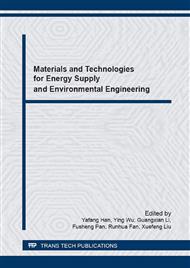[1]
S.Y. Song, Introduction to the development of building energy saving windows and curtain wall. Science & Technology Information, 7 (2011) 87-88.
Google Scholar
[2]
N. Ding, Life cycle assessment of typical aluminum alloys, Ph.D. Dissertation of Beijing University of Technology, (2012).
Google Scholar
[3]
Z.H. Huo, Research on formule for PVC wood composite profile. Engineering Plastics Application, 35 (2007) 33-35.
Google Scholar
[4]
X. Su, LCA-based optimization of window-wall ratio and window materials of typical office building in Shanghai. Building Science, 6 (2008) 66-70.
Google Scholar
[5]
Z.H. Cui, A Comprehensives evaluation on double skin facade, Ph.D. Dissertation of Zhejiang University, (2014).
Google Scholar
[6]
C.Z. Zhao, Q. Jiang, L.P. Ma. Life Cycle Assessment of typical broken-bridge aluminum alloy window. China Building Materials Science & Technology. 06 (2013) 62-65.
Google Scholar
[7]
J. Salazar, T. Sowlati, Life cycle analysis of windows for the North American residential market case study. Scand. J. Forest Res. 23(2008) 121-132.
DOI: 10.1080/02827580801906981
Google Scholar
[8]
S. Arijit, K. Andreja, Carbon footprint versus performance of aluminum, plastic and wood window frames from cradle to gate. Buildings, 2(2012) 542-553.
DOI: 10.3390/buildings2040542
Google Scholar
[9]
G. F Menzies, Whole Life Analysis of timber, modified timber and aluminum-clad timber windows: Service Life Planning (SLP), Whole Life Costing (WLC) and Life Cycle Assessment (LCA). Edinburgh: Heriot-Watt University, (2013).
DOI: 10.4324/9781315528175-9
Google Scholar
[10]
W.X. Shen, F. Gao, et al, Environment impact analysis of primary magnesium and magnesium alloy production. Light Metals. 1 (2011) 43-47.
Google Scholar
[11]
H.L. Ye, H.W. Ma, B. Yang, et al, LCA study of metallurgical silicon process. Light Metals. 11 (2007) 46-49.
Google Scholar
[12]
Y.K. Yang, Life Cycle Assessment of typical non-metallic mining fillers, Ph.D. Dissertation of Beijing University of Technology, (2012).
Google Scholar
[13]
M.N. Zhao, Life Cycle Assessment of concrete structural component of dwelling, Ph.D. Dissertation of Beijing University of Technology, (2013).
Google Scholar
[14]
Y.F. Zhang, X.Z. Gong, et al. Environment Impact of Freight Transportation in China. Material Science Forum, 4 (2014) 144-151.
Google Scholar
[15]
X. H. Di, Z. E, Nie, et al, Life Cycle inventory for electricity generation in China, Int J LCA. 12 (2007) 217-224.
Google Scholar
[16]
F. Gao, Life Cycle Assessment and its application in China magnesium industry. Beijing: Ph.D. Dissertation of Beijing University of Technology, (2005).
Google Scholar
[17]
B. Jeroen, et al. Life cycle assessment: An operational guide to the ISO standards. Dordrecht: Kluwer Academic Publishers, (2001).
Google Scholar
[18]
A.W. Sleeswijk, et al Normalization in product life cycle assessment: An LCA of the global and European economic systems in the year 2000, Science of the total environment. 390 (2008) 227-240.
DOI: 10.1016/j.scitotenv.2007.09.040
Google Scholar
[19]
F. Gao, Z.R. Nie, ZH.H. Wang, Characterization and normalization factors of a biotic resource depletion for life cycle impact assessment in China, J. Science in China Series E: Technological Sciences. 52 (2009) 215-222.
DOI: 10.1007/s11431-009-0028-1
Google Scholar


